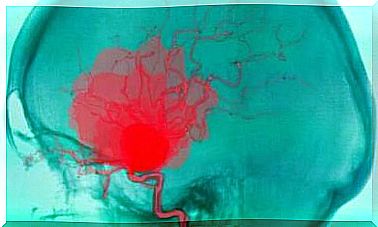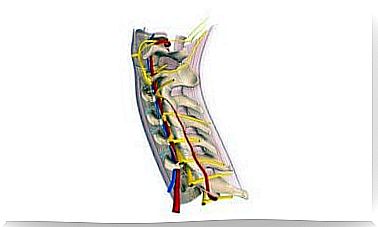Recommended Exercises For Dizziness

According to the Spanish Association of Otorhinolaryngology and Head and Neck Surgery, about 80% of people experience a dizziness at some point in their lives, and it is more common in adults over 40 years of age. In this article, we share some recommended exercises for dizziness that will help relieve symptoms.
Although dizziness is different and can be caused by different reasons, the most common form, benign postural dizziness, is due to a problem in the inner ear. It usually occurs as a result of small changes in posture or head movement.
In principle, benign postural dizziness involves the movement of small lime crystals in the inner ear, which help maintain balance, into the semicircular arches of the ear. In this case, they cause the feeling that everything is revolving around.
Recommended exercises for dizziness
Exercises for dizziness help crystals that have been placed in the wrong place to return to the inner ear, where they do not cause the symptoms of dizziness. However, before doing these exercises, it is important to find out which ear the problem is causing.
The easiest way to figure this out is to turn your head to the right and then to the left looking over your shoulder. After that, you should be able to say which direction causes more dizziness. If the feeling of dizziness intensifies, for example, when you tilt your head to the left, this is probably the problem side.

Epley’s maneuver
Epley’s maneuver consists of several head movements, usually performed under the guidance of a doctor or physiotherapist. This is done as follows:
- While the patient is sitting at the examination table, the doctor turns his or her head 45 degrees toward the problematic ear.
- The doctor then asks the patient to lie down so that the head remains tilted and hangs over the edge of the examination table. At this point, the patient is likely to be dizzy. The head should be held in this position until the dizziness passes.
- The doctor then turns the patient’s head 90 degrees toward a healthy ear, thus moving the lime crystals back into place.
A self-made version of Epley’s maneuver
While this movement should be supervised by a professional, here’s what we’ll do with the home version:
- Sit on the bed with your legs outstretched straight in front of you with a pillow under them.
- Put another pillow behind you so that it is under your shoulders when you lie down.
- Turn your head 45 degrees toward the problem ear.
- Lean back quickly, lowering your shoulders on the pillow and wait half a minute.
- Turn your head 90 degrees to the opposite side and wait half a minute again.
- Return to sitting position.
Semontic maneuver
Like Epley’s maneuver, Semont’s maneuver should be done under the guidance of a doctor or physiotherapist. This is done as follows:
- While the patient is sitting at the examination table, the expert turns his head 45 degrees to the side of the healthy ear.
- The specialist then puts the patient lying on the side of the problem ear side with the head turned turned. The patient stays in this position for half a minute.
- Later, the patient can return to the starting position.
Foster’s maneuver
Foster’s maneuver is one easier to accomplish because it doesn’t require a lying position in bed or anyone else’s help. You should follow these steps:
- Get your knees on a comfortable surface and place your palms against the floor. Move your head up and down until you feel dizzy.
- Then take your head towards the floor trying to touch your knees.
- Without lifting your head off the floor, turn it 45 degrees to the side facing the problem ear, looking over your shoulder.
- Stay in this position for half a minute.
- When your head is tilted to a 45-degree angle, raise it to the same level as your shoulders. Wait another half minute in this position.
- After half a minute, lift your head straight.
For this maneuver to be effective, it must be repeated three to five times, with a 15-minute break between each exercise.
Brandt-Daroff’s business series
Brandt-Daroff exercises are very easy to do at home as well. You need to sit on the bed and follow these steps:
- Go to your side lying with your head raised at a 45 degree angle to the bed.
- Stay in this position for half a minute or at least until the dizziness disappears.
- Then return to the sitting position.
- Go to the opposite side of the bed and repeat the same as just now.
According to a study published in the Journal of Physiotherapy at the Catholic University of San Antonio de Murcia, Brandt-Daroff exercises are very effective when a patient does five sets at least three times a day for two consecutive weeks.
Other recommended exercises for dizziness
There are also other exercises recommended by experts for dizziness that can help overcome the discomfort. It is important to do these exercises carefully so that you do not fall or hurt yourself as a result of the fainting that may be associated with that syndrome.
Exercises for dizziness: balance and posture control
The goal of these exercises is to provide an appropriate motor response to certain sensory stimuli to improve balance. Here are some of the easiest exercises:
- Go up and down ten steps with your eyes open several times. Then repeat this exercise with your eyes closed.
- Keep your feet apart and your ankles on the mat and move your weight forward and backward without bending your hips, mimicking the movement of the pendulum. Then repeat this exercise several times on both sides. When you are done, repeat the same with your eyes closed.
- Walk your toes forward and back in a straight line. Do this with your eyes open first and then your eyes closed.
- Stand on one leg for half a minute. Do this with your eyes open first and then closed. Repeat five times for each leg.
- Stand near a platform where you can take support and raise one foot to draw the alphabet in the air. Once you have done this with one leg, repeat with the other leg.

Exercise to improve eye reflexes and stabilize eyes
The purpose of this exercise is to improve eye interaction during major movements and improve gaze stability. To do this, attach the card to a wall and stand about 25 inches away from it.
Then move your head slowly sideways from left to right, trying to keep your gaze on the letters. Do this exercise for a minute, take a break and repeat this time vertically.
Ask your doctor before doing these exercises for dizziness
While these exercises are usually helpful, it is still important to first discuss with your doctor about your own dizziness and the exercises that are the best option in your particular case. This is especially important if you have a neck or back injury.
The feeling of dizziness is normal when doing these exercises. They should be done calmly, take a break between sets and wait a few minutes before getting up to stand.









